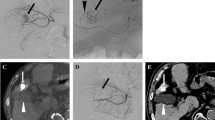Abstract
The purpose of this study was to report a new technique for localization of hepatic tumors that are poorly visible with CT fluoroscopy. Forty-three hepatocellular carcinomas were not visible with CT fluoroscopy. A 22-gauge Chiba end-hole needle was inserted in the approximate location of a lesion estimated on the basis of anatomical landmarks demonstrated on both previous MR and CT images. We injected 3 ml of a mixture of nonionic contrast material and saline solution. Following the first injection, contrast solution filled the hepatic lesion in 29 of 43 cases. In 8 of 43 cases, contrast solution was distributed in the normal surrounding liver. In 7 of these 8 cases, repositioning allowed us to adjust the needle in the tumor. In the other 6 of 43 cases, contrast solution spread within capsule or pseudocapsule (pattern 3). In all 6 cases, repositioning allowed to adjust the needle in the tumor. This new technique allows an accurate localization of hepatic tumors that are poorly visible with CT fluoroscopy.





Similar content being viewed by others
References
Boss A, Clasen S, Kuczyk M et al (2005) Magnetic resonance-guided percutaneous radiofrequency ablation of renal cell carcinomas: a pilot clinical study. Invest Radiol 40:583–590
Shibata T, Iimuro Y, Yamamoto Y et al (2002) CT-guided transthoracic percutaneous ethanol injection for hepatocellular carcinoma not detectable with US. Radiology 223:115–120
Kirchner J, Kickuth R, Walz MV, Schilling EM, Laufer U, Liermann D (1999) CTF-guided puncture of an unenhanced isodense liver lesion during continuous intravenous injection of contrast medium. Cardiovasc Intervent Radiol 22:528–530
Schweiger GD, Brown BP, Pelsang RE, Dhadha RS, Barloon TJ, Wang G (2000) CT fluoroscopy: technique and utility in guiding biopsies of transiently enhancing hepatic masses. Abdom Imaging 25:81–85
Solomon SB, Bohlman ME, Choti MA (2002) Percutaneous gadolinium injection under MR guidance to mark target for CT-guided radiofrequency ablation. J Vasc Interv Radiol 13:419–421
Adam A, Hatzidakis A, Hamady M, Sabharwal T, Gangi A (2004) Percutaneous coil placement prior to radiofrequency ablation of poorly visible hepatic tumors. Eur Radiol 14:1688–1691
Cha CH, Lee FT Jr, Gurney JM et al (2001) CT versus sonography for monitoring radiofrequency ablation in a porcine liver. Am J Roentgenol 176:1077–1078
Valls C, Cos M, Figueras J et al (2004) Pretransplantation diagnosis and staging of hepatocellular carcinoma in patients with cirrhosis: value of dual-phase helical CT. Am J Roentgenol 182:1011–1017
Daly B, Templeton PA (1999) Real-time CT fluoroscopy: evolution of an interventional tool. Radiology 211:309–315
Nicolau C, Vilana R, Bru C (2004) The use of contrast-enhanced ultrasound in the management of the cirrhotic patient and for detection of HCC. Eur Radiol 14(Suppl 8):P63–P71
Nicolau C, Catala V, Vilana R et al (2004) Evaluation of hepatocellular carcinoma using SonoVue, a second generation ultrasound contrast agent: correlation with cellular differentiation. Eur Radiol 14:1092–1099
Kino Y, Odagiri K, Andoh K, Itoh Y, Tarao K (1993) Gadopentate dimeglumine as an alternative contrast material for use in angiography. Am J Roentgenol 160:1293–1294
Arrivé L, Rosmorduc O, Dahan H et al (2003) Percutaneous acetic acid injection for hepatocellular carcinoma: using CT fluoroscopy to evaluate distribution of acetic acid mixed with an iodinated contrast agent. Am J Roentgenol 180:159–162
Ferrucci JT Jr, Wittenberg J (1978) CT biopsy of abdominal tumors: aids for lesion localization. Radiology 129:739–744
Carlson SK, Felmlee JP, Bender CE et al (2003) Intermittent-mode CT fluoroscopy-guided biopsy of the lung or upper abdomen with breath-hold monitoring and feedback: system development and feasibility. Radiology 229:906–912
Author information
Authors and Affiliations
Corresponding author
Rights and permissions
About this article
Cite this article
Arrivé, L., Rosmorduc, O., Azizi, L. et al. A new technique for localization of hepatic tumors that are poorly visible with CT fluoroscopy. Eur Radiol 16, 2811–2816 (2006). https://doi.org/10.1007/s00330-006-0231-4
Received:
Accepted:
Published:
Issue Date:
DOI: https://doi.org/10.1007/s00330-006-0231-4




